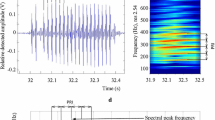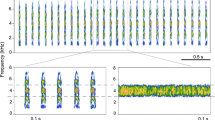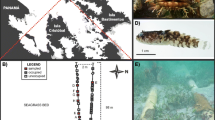Abstract
We quantified crepuscular variation in the emission rate and call properties of the boatwhistle advertisement call of Gulf toadfish, Opsanus beta, from a field recording of a natural population of nesting males in the Florida Keys. Their calls are more variable and complex than previously reported. A call typically starts with a grunt followed by one to five tonal boop notes (typically two or three) and lasts for over a second. The first boop is considerably longer than later ones, and intervals between boops are relatively constant until the final interval, which approximately doubles in duration. Positions of fish are fixed and calls are sufficiently variable that we could discern individual callers in field recordings. Calling rate increases after sunset when males tend to produce shorter calls with fewer notes. Analysis by number of notes per call indicates some individuals decrease the number of initial grunts and the duration of the first note, but most of the decrease results from fewer notes. To our knowledge this sort of call plasticity has not been demonstrated before in fishes. We suggest that call shortening lowers the chances of overlapping calls of other males and that the small amount of time actually spent producing sound (total on time) is an adaptation to prevent fatigue in sonic muscles adapted for speed but not endurance.
Similar content being viewed by others
References cited
Appelt, D., V. Shen & C. Franzini-Armstrong. 1991. Quantitation of Ca ATPase, feet andmitochondria in super fast muscle fibers from the toadfish, Opsanus tau. J. Muscle Res. Cell Motil. 12: 543–552.
Barimo, J.F. & M.L. Fine. 1998. Relationship of swim-bladder shape to the directionality pattern of underwater soundin the oyster toadfish. Can. J. Zool. 76: 134–143.
Bass, A.H., M. Marchaterre & R. Baker. 1994.Vocal-acoustic pathways in a teleost fish. J. Neurosci. 14: 4025–4039.
Bendix, Jr., J.H. & P.M. Narins.1999. Competitive calling behavior by male treefrogs, Eleutherodactylus coqui (Anura: Leptodactylidae). Copeia 1999: 1118–1122.
Breder, C. Jr. 1968. Seasonal and diurnal occurrences of fish sounds in a small Florida Bay. Bull.Amer. Mus. Nat. Hist. 138: 325–378.
Fawcett, D.W. & J.P. Revel. 1961. The sarcoplasmic reticulum of afast-acting muscle. Biophys. Biochem. Cytol. 10(Suppl): 89–109.
Feher, J.J., T.D. Waybright & M.L. Fine 1998. Comparison of sarcoplasmic reticulum capabilities in toadfish (Opsanus tau) sonic muscle and rat fast twitch muscle. J. Muscle Res. Cell Motil. 19: 661–674.
Fine, M.L. 1978. Seasonal and geographic variationof the mating call of the oyster toadfish Opsanus tau. Oecologia 36: 45–57.
Fine, M.L. 1979. Geographicalvariation in sound production evoked by brain stimulation in the oyster toadfish. Naturwissenschaften 65: 493.
Fine, M.L. & M.L. Lenhardt. 1983. Shallow-water propagation of the toadfish mating call. Comp. Biochem.Physiol. 76A: 225–231.
Fine, M.L., B. Bernard & T.M. Harris. 1993. Functional morphology of toadfishsonic muscle fibers: relationship to possible fiber division. Can. J. Zool. 71: 2262–2274.
Fine, M.L., H.E. Winn& B.L. Olla. 1977a. Communication in fishes. pp. 472–518. In: T.A. Sebeok (ed.) How Animals Communicate, Indiana University Press, Bloomington.
Fine, M.L., L. Joest, H.E. Winn & P.J. Perkins. 1977b.Temporal aspects of calling behavior in the oyster toadfish, Opsanus tau. U.S. Fish. Bull. 75: 871–874.
Fish, J.F.1972. The effect of sound playback on the toadfish. pp. 386–434. In: H.E. Winn & B.L. Olla (ed.) Behavior of Marine Animals, Vol. 2, Plenum Press, New York
Fish, M.P. 1954. Character and significance of soundproduction among fishes of the Western North Atlantic. Bull. Bingham Oceanogr. Coll. 14: 1–109.
Franzini-Armstrong, C. & G. Nunzi. 1983. Junctional feet and particles in the triads of a fast-twich muscle fiber. J. Muscle Res. Cell Motil. 4: 233–252.
Gray, G.A. & H.E. Winn. 1961. Reproductive ecology and sound productionof the toadfish Opsanus tau. Ecology 28: 274–282.
Hawkins, A.D. 1986. Underwater sound and fishbehavior. pp. 114–151. In: T.J. Pitcher (ed.) Behavior of Teleost Fishes, Chapman and Hall, London.
Loesser, K.E., J. Rafi & M.L. Fine. 1997. Embryonic, juvenile, and adult development of the toadfish sonic muscle.Anat. Rec. 249: 469–477.
McKibben, J.R. & A.H. Bass. 1998. Behavioral assessment of acousticparameters relevant to signal recognition and preference in a vocal fish. J. Acoust. Soc. Amer. 104: 3520–3533.
Mitchell, S. 1997. Muscle fatigue and glycogen levels in the sonic swimbladder muscle of the oyster toadfish (Opsanustau). Master's Thesis, Virginia Commonwealth University, Richmond. 80 pp.
Myrberg, Jr. A.A. 1981. Soundcommunication and interception in fishes. pp. 395–426. In: W.N. Tavolga, A.N. Popper & R.R Fay (ed.) Hearing and Sound Communication in Fishes, Springer Verlag, New York
Prestwich, K.N. 1994. The energetics of acousticsignalling in anurans and insects. Amer. Zool. 34: 625–643.
Rome, L.C. & S.L. Lindstedt. 1998. Thequest for speed: muscles built for high-frequency contractions. News Physiol. Sci. 13: 261–268.
Rome, L.C.,D.A. Syme, S. Hollingworth., S.L. Lindstedt & S.M. Baylor. 1996. The whistle and the rattle: the design of sound producing muscles. Proc. Nat. Acad. Sci. 93: 8095–8100.
Rome, L.C., C. Cook, D.A. Syme, M.A. Connaughton, M. Ashley-Ross, A. Klimov, B. Tikunov & Y.E. Goldman. 1999. Trading force for speed: why superfast crossbridge kinetics leads to superlow forces. Proc. Nat. Acad. Sci. 96: 5826–5831.
Tavolga, W.N.1958. Underwater sounds produced by two species of toadfish Opsanus tau and Opsanus beta. Bull. Mar. Sci. 8: 278–284.
Tavolga, W.N. 1964. Sonic characteristics and mechanisms in marine fishes. pp. 195–211. In:W.N. Tavolga (ed.) Marine Bio-Acoustics, Pergamon Press, New York.
Tavolga, W.N. 1971. Soundproduction and detection. pp. 135–205. In: W.S. Hoar & D.J. Randall (ed.) Fish Physiology, Vol. 5, Academic Press, New York.
Winn, H.E. 1964. The biological significance of fish sounds. pp. 213–231. In:W.N. Tavolga (ed.) Marine Bio-Acoustics, Pergamon Press, New York.
Winn, H.E. 1967. Vocalfacilitation and the biological significance of toadfish sounds. pp. 213–231. In: W.N. Tavolga (ed.) Marine Bio-Acoustics, Vol. 2, Pergamon Press, New York.
Winn, H.E. 1972. Acoustic discrimination by the toadfish withcomments on signal systems. pp. 361–385. In: H.E. Winn & B.L. Olla (ed.) Behavior of Marine Animals: Current Perspectives in Research, Vol. 2, Vertebrates, Plenum Press, New York.
Zelick, R., D. Mann & A.N. Popper.1999. Acoustic communication in fishes and frogs. pp. 363–411. In: R.R. Fay & A.N. Popper (ed.) Comparative Hearing: Fish and Amphibians, Springer-Verlag, New York.
Author information
Authors and Affiliations
Corresponding author
Rights and permissions
About this article
Cite this article
Thorson, R.F., Fine, M.L. Crepuscular Changes in Emission Rate and Parameters of the Boatwhistle Advertisement Call of the Gulf Toadfish, Opsanus Beta . Environmental Biology of Fishes 63, 321–331 (2002). https://doi.org/10.1023/A:1014334425821
Issue Date:
DOI: https://doi.org/10.1023/A:1014334425821




